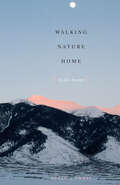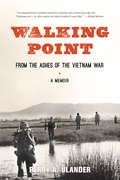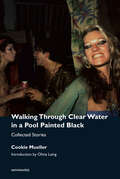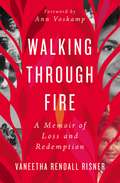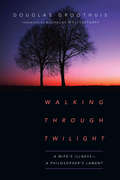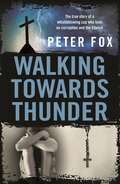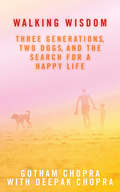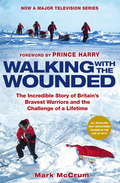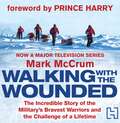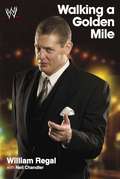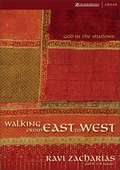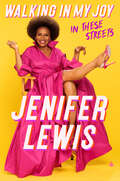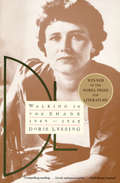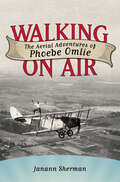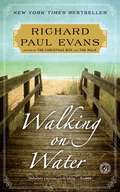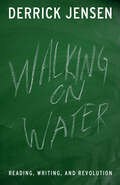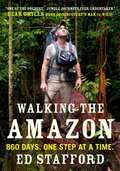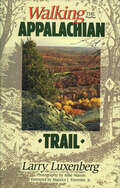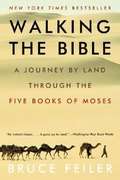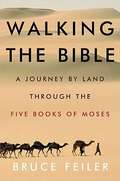- Table View
- List View
Walking Nature Home: A Life's Journey (Louann Atkins Temple Women & Culture Series)
by Susan J. Tweit&“Offers the reader a constellation of healing stories . . . Powerful articulations of the human heart . . . Overlaid with the stories of the natural world&” (Denise Chávez, author of A Taco Testimony: Meditations on Family, Food, and Culture). Without a map, navigate by the stars. Susan Tweit began learning this lesson as a young woman diagnosed with an autoimmune disease that was predicted to take her life in two to five years. Offered no clear direction for getting well through conventional medicine, Tweit turned to the natural world that was both her solace and her field of study as a plant ecologist. Drawing intuitive connections between the natural processes and cycles she observed and the functions of her body, Tweit not only learned healthier ways of living but also discovered a great truth—love can heal. In this beautifully written, moving memoir, she describes how love of the natural world, of her husband and family, and of life itself literally transformed and saved her own life. In tracing the arc of her life from young womanhood to middle age, Tweit tells stories about what silence and sagebrush, bird bones and sheep dogs, comets, death, and one crazy Englishman have to teach us about living. She celebrates making healthy choices, the inner voices she learned to hear on days alone in the wilderness, the joys of growing and eating an organic kitchen garden, and the surprising redemption in restoring a once-blighted neighborhood creek. Linking her life lessons to the stories she learned in childhood about the constellations, Tweit shows how qualities such as courage, compassion, and inspiration draw us together and bind us into the community of the land and of all living things.
Walking Papers: The Accident that Changed My Life, and the Business that Got Me Back on My Feet
by Francesco ClarkWalking Papers is the incredibly inspiring story of a young man who wouldn't give up. Francesco Clark was a twenty-four-year-old with a bright future when he went to Long Island for the weekend--but a nocturnal dive into the pool's shallow end changed everything, forever. Paralyzed from the neck down, Francesco was told by his doctors that he would never move from his bed or even breathe without assistance. But Francesco fought back. Within days, he was breathing on his own. His father, a doctor himself, investigated every opportunity for experimental treatment, and Francesco used every resource available to speed his recovery. To avoid having his lungs painfully suctioned, he sang, loudly, for hours--and that was just the beginning. Francesco moved back home with his parents and began the long process toward recovery. Many doctors discourage patients with spinal cord injury from pursuing physical therapy beyond very basic movements, but Francesco embarked on a five-hour daily regimen, including the treadmill program that Christopher Reeve had made famous. Soon he astounded the medical establishment with his progress. Francesco's accident also left him unable to sweat out toxins, leaving his complexion poor. He and his father began to experiment, and the Clark's Botanicals skin-care line was born. Now CB products are sold worldwide in stores such as Saks Fifth Avenue, and the company has won many major fashion awards and is enjoyed by a host of celebrities. The lessons Francesco learned about persistence from his recovery process, and the loving support of his amazing family, have both contributed to his incredible business success. Seven years after the accident, Francesco continues to improve and to surprise his doctors--for instance, he can now work on a computer. Walking Papers is the inspiring story of how, with individual determination and unconditional family support, Francesco Clark overcame extreme adversity and achieved an extraordinary triumph.
Walking Point: From the Ashes of the Vietnam War
by Perry A. UlanderIn this intimate memoir, Perry A. Ulander chronicles with powerful clarity the bewildering predicament he confronted and the fellowship and guidance that transformed him during the year he served as an American GI in the jungles of Vietnam. Conveying with unadorned precision the harrowing experiences that shatter his core beliefs, Ulander also captures the camaraderie and humor of his platoon, the hostility between "lifers" and draftees, the physical hardships of reconnaissance missions, and the unrelenting apprehension underlying everyday life. Ultimately, he describes the surrendering of social norms and accepted identities that allows him to glimpse a previously unimagined realm of heightened awareness. Written after a lifetime of reflection on the nature of war and the effect of violence and domination on the minds and spirits of those forced to practice it, Walking Point offers a powerful narrative for readers with an interest in the effects of war and violence, American involvement in Vietnam, PTSD, and how trauma can be a catalyst for spiritual transformation. Giving voice to profound insights gained through extreme adversity, Ulander movingly captures the depth of trust and commitment among a group of unwitting warriors who struggle to stay alive and sane in unchartered territory. Contents CHAPTER 1: Into the Unknown CHAPTER 2: The Magic Poncho Liner CHAPTER 3: Initiation CHAPTER 4: Head On CHAPTER 5: The Valley of the Shadow CHAPTER 6: Into the Light CHAPTER 7: Short Time CHAPTER 8: No Time CHAPTER 9: HomeFrom the Trade Paperback edition.
Walking Stars: Stories of Magic and Power
by Victor VillasenorWalking Stars, by Victor Villasenor, is a collection of autobiographical short stories. The author shares some stories from his own life, stories his mother and father told him, and stories that have been passed down in the family from generation to generation. After each story, Villasenor provides comments in brief Author's Notes. Many of the stories in Walking Stars contain fantasy elements.
Walking Through Clear Water in a Pool Painted Black, new edition: Collected Stories (Semiotext(e) / Native Agents)
by Cookie MuellerThe first collected edition of legendary writer, actress, and adventurer Cookie Mueller's stories, featuring the entire contents of her 1990 book Walking through Clear Water in a Pool Painted Black, alongside more than two dozen others, some previously unpublished.Legendary as an underground actress, female adventurer, and East Village raconteur, Cookie Mueller's first calling was to the written word: "I started writing when I was six and have never stopped completely," she once confessed. Muellerís 1990 Walking through Clear Water in a Pool Painted Black, the first volume of the Semiotext(e) Native Agents series, was the largest collection of stories she compiled during her life. But it presented only a slice of Mueller's prolific work as a writer. This new, landmark volume collects all of Mueller's stories: from the original contents of Clear Water, to additional stories discovered by Amy Scholder for the posthumous anthology Ask Dr. Mueller, to selections from Mueller's art and advice columns for Details and the East Village Eye, to still "new" stories collected and published here for the first time. Olivia Laing's new introduction situates Mueller's writing within the context of her life—and our times. Thanks to recent documentaries like Mallory Curley's A Cookie Mueller Encyclopedia and Chloé Griffin's oral biography Edgewise, Mueller's life and work have been discovered by a new generation of readers. Walking through Clear Water in a Pool Painted Black: Collected Stories returns essential source material to these readers, the archive of Mueller's writing itself. Mueller's many mise en scènes—the Baltimore of John Waters, post-Stonewall Provincetown, avant-garde Italy, 1980s New York, an America enduring Reagan and AIDS—patches together a singular personal history and a primer for others. As Laing writes in her introduction, Collected Stories amounts to "a how-to manual for a life ricocheting joyously off the rails . . . a live corrective to conformity, conservatism, and cruelty."
Walking Through Fire: A Memoir of Loss and Redemption
by Vaneetha Rendall RisnerThe astonishing, Job-like story of how an existence filled with loss, suffering, questioning, and anger became a life filled with shocking and incomprehensible peace and joy.Vaneetha Risner contracted polio as an infant, was misdiagnosed, and lived with widespread paralysis. She lived in and out of the hospital for ten years and, after each stay, would return to a life filled with bullying. When she became a Christian, though, she thought things would get easier, and they did: carefree college days, a dream job in Boston, and an MBA from Stanford where she met and married a classmate.But life unraveled. Again. She had four miscarriages. Her son died because of a doctor's mistake. And Vaneetha was diagnosed with post-polio syndrome, meaning she would likely become a quadriplegic. And then her husband betrayed her and moved out, leaving her to raise two adolescent daughters alone. This was not the abundant life she thought God had promised her. But, as Vaneetha discovered, everything she experienced was designed to draw her closer to Christ as she discovered "that intimacy with God in suffering can be breathtakingly beautiful."
Walking Through Twilight: A Wife's Illness—A Philosopher's Lament
by Douglas GroothuisHow do you continue to find God as dementia pulls your loved one into the darkness? Nothing is simple for a person suffering from dementia, and for those they love. When ordinary tasks of communication, such as using a phone, become complex, then difficult, and then impossible, isolation becomes inevitable. Helping becomes excruciating. In these pages philosopher Douglas Groothuis offers a window into his experience of caring for his wife as a rare form of dementia ravages her once-brilliant mind and eliminates her once-stellar verbal acuity. Mixing personal narrative with spiritual insight, he captures moments of lament as well as philosophical and theological reflection. Brief interludes provide poignant pictures of life inside the Groothuis household, and we meet a parade of caregivers, including a very skilled companion dog. Losses for both Doug and Becky come daily, and his questions for God multiply as he navigates the descending darkness. Here is a frank exploration of how one continues to find God in the twilight.
Walking Towards Thunder: The true story of a whistleblowing cop who took on corruption and the Church
by Peter FoxFormer Detective Chief Inspector Peter Fox is a hero in many people's eyes. A police officer with 36 years' service in the Hunter region, he rose to national prominence in 2012 for his major role in speaking out for the victims of abuse within the church. He had been at the coalface fighting these heinous crimes for decades. He had worked with the victims and supported their families. He knew an enquiry was long overdue. His decision to become a whistle blower helped trigger Prime Minister Julia Gillard's historic decision to establish a far-reaching Royal Commission into the sexual abuse of children in institutions.He had no idea what speaking up would unleash. Peter's dedication and focus cost him his career, his health and also affected his wife's health. He and his family were threatened. Former friends shunned him. But the victims and the families that he supported consider him their champion. To them he is a hero.Walking Towards Thunder details the cumulative horrors our police face every day, it reveals the cover ups and the way sexual predators were moved around. It shows the backlash he faced and the lengths those in power will go to avoid facing the truth. Confronting and inspiring, this is an unforgettable story.
Walking Wisdom: Three Generations, Two Dogs, and the Search for a Happy Life (Playaway Adult Nonfiction Ser.)
by Deepak Chopra Gotham ChopraWalking Wisdom is a memoir of spirituality across three generations. Looking back as a new father, Gotham Chopra considers the lessons he wishes to pass to his own son. When reflecting back on the strongest influences in his life, the first was no surprise: his father. But the second was unexpected: his dogs.Growing up, Gotham Chopra and his sister were exposed to everything from the Bible to biology, from the Bhagavad Gita to Brave New World. They were also the ubiquitous and unwitting guinea pigs for their physician father's endless spiritual experiments. Gotham's childhood was part spiritual, part scientific and totally unique, but somehow he ended up (relatively) normal. Walking Wisdom is a poignant and powerful narrative that chronicles all of the love and licks that come with having a dog, along with the contradictions, complexities and the consequences of having children.
Walking With The Wounded: The Incredible Story of Britain's Bravest Warriors and the Challenge of a Lifetime
by Mark McCrumIn April 2011, four soldiers - each a hero of recent conflicts who suffered devastating injuries in the line of duty - set out on a challenge that even an able-bodied athlete would balk at. A two-hundred mile trek, unsupported, to the North Pole.It was the culmination of a journey that began long before, when two friends decided to mount an expedition that would demonstrate how remarkable our armed forces are and raise funds for the rehabilitation of injured service men and women. Little did they know that their idea would ultimately gain global attention, and royal endorsement. The year-long selection process was more physically and emotionally draining than anyone had anticipated. But by September 2010 the final team was set: the two founders, four wounded soldiers, a polar guide, and patron Prince Harry. Once they'd ventured inside the arctic circle they had to contend with new challenges. Pulling sleds weighing more then 100kg over vast swathes of ice rubble, pressure ridges and dangerous open water 'leads'; constant daylight; ground that could literally tear itself apart beneath them as they slept; and temperatures as low as -35 degrees. And all the time, they had to be alert for signs of the notoriously aggressive Polar Bears that roam the desolate landscape. With every step fraught with risk, the trek tested its participants' resilience to the limit. Each of these brave men tells their story here, along with that of the extraordinary expedition itself - the rigorous training, the meticulous preparation, and of course, the final, awe-inspiring journey across the ice. They returned as heroes again - proof that strength of mind can be every bit as powerful as strength of body, and an inspiration to us all.
Walking With The Wounded: The Incredible Story of Britain's Bravest Warriors and the Challenge of a Lifetime
by Mark McCrumIn April 2011, four soldiers - each a hero of recent conflicts who suffered devastating injuries in the line of duty - set out on a challenge that even an able-bodied athlete would balk at. A two-hundred mile trek, unsupported, to the North Pole.It was the culmination of a journey that began long before, when two friends decided to mount an expedition that would demonstrate how remarkable our armed forces are and raise funds for the rehabilitation of injured service men and women. Little did they know that their idea would ultimately gain global attention, and royal endorsement. The year-long selection process was more physically and emotionally draining than anyone had anticipated. But by September 2010 the final team was set: the two founders, four wounded soldiers, a polar guide, and patron Prince Harry. Once they'd ventured inside the arctic circle they had to contend with new challenges. Pulling sleds weighing more then 100kg over vast swathes of ice rubble, pressure ridges and dangerous open water 'leads'; constant daylight; ground that could literally tear itself apart beneath them as they slept; and temperatures as low as -35 degrees. And all the time, they had to be alert for signs of the notoriously aggressive Polar Bears that roam the desolate landscape. With every step fraught with risk, the trek tested its participants' resilience to the limit. Each of these brave men tells their story here, along with that of the extraordinary expedition itself - the rigorous training, the meticulous preparation, and of course, the final, awe-inspiring journey across the ice. They returned as heroes again - proof that strength of mind can be every bit as powerful as strength of body, and an inspiration to us all.
Walking With The Wounded: The Incredible Story of Britains Bravest Warriors and the Challenge of a Lifetime
by Mark McCrum Prince HarryIn April 2011, four soldiers - each a hero of recent conflicts who suffered devastating injuries in the line of duty - set out on a challenge that even an able-bodied athlete would balk at. A two-hundred mile trek, unsupported, to the North Pole.It was the culmination of a journey that began long before, when two friends decided to mount an expedition that would demonstrate how remarkable our armed forces are and raise funds for the rehabilitation of injured service men and women. Little did they know that their idea would ultimately gain global attention, and royal endorsement. The year-long selection process was more physically and emotionally draining than anyone had anticipated. But by September 2010 the final team was set: the two founders, four wounded soldiers, a polar guide, and patron Prince Harry. Once they'd ventured inside the arctic circle they had to contend with new challenges. Pulling sleds weighing more then 100kg over vast swathes of ice rubble, pressure ridges and dangerous open water 'leads'; constant daylight; ground that could literally tear itself apart beneath them as they slept; and temperatures as low as -35 degrees. And all the time, they had to be alert for signs of the notoriously aggressive Polar Bears that roam the desolate landscape. With every step fraught with risk, the trek tested its participants' resilience to the limit. Each of these brave men tells their story here, along with that of the extraordinary expedition itself - the rigorous training, the meticulous preparation, and of course, the final, awe-inspiring journey across the ice. They returned as heroes again - proof that strength of mind can be every bit as powerful as strength of body, and an inspiration to us all.
Walking a Golden Mile
by William Regal Neil ChanlderThe bare-fisted brawler from Blackpool, England tells his story of fortune and fumbling on the road to the WWE's higher ranks.Since joining the WWE in 2000 as a goodwill ambassador from Great Britain, William Regal has established himself as an up-and-coming Superstar. He took the wrestling world by storm defeating many of the WWE's best wrestlers to win both the European and Intercontinental championships--although he's probably best known for getting back in WWE owner's Vince McMahon's good graces by kissing his naked backside on national television. While fans may still chuckle at Regal's humiliation, his in-ring success is no laughing matter. In this no-holds-barred look at his life, Regal for the first time talks about how he has dragged himself out of a life of poverty and adversity on the street of Blackpool, England and battled his own inner-demons to reach the top of the WWE's roster. He also discusses how he has overcome his recent life-threatening medical condition to return to triumphantly to the WWE.to admit when I know so many kids watch me on TV every week, but it's true. I detested it. My first school was a Catholic school, St Joseph's Convent, even though I'm not a Catholic. Mum leaving when I was so young didn't help matters, but I would never have been able to handle being preached at by those nuns in any case. I never liked being told that I'd go to hell if I didn't do what some nun told me to. Just about the only highlight I remember from school was being taken on a trip to Chester Zoo when I was eight. My best friend was a lad called Andrew who had this curly thick white hair. He began pulling faces at a gorilla who retaliated by throwing a big pile of shite at him, hitting him square in the face. All you could see of Andrew were his eyes, peering through this steaming mask. The nuns were running around, shouting and screaming. It was like a Tom and Jerry cartoon. If that was the only thing I can remember from school, you can imagine how mind-numbing I found the place. Then when I was nine I went to the middle school -- and was soon faced with another confusing situation. My mum had run off with this bloke and my dad ended up marrying his wife. It got pretty complicated. I've a half-brother who's my mum and step-dad's kid, and a step-sister. My dad had custody of me and I'd go to stay with my mum in the school holidays, but I didn't like going. She lived in Bristol, a hundred miles away. When I was there I never saw much of my brother, who was always out with his friends. I didn't really know him, though we do keep in touch today. He's nice enough. But most of the time I didn't want to be there because I wanted to stay at home with my dad, granddad and the close family who lived nearby: my uncles, aunties and cousins -- especially my cousin Graham. He's older than me, but we spent so much time together growing up that he's more like a brother to me than anything else. But my dad was always the one I looked up to. To this day he's the nicest man I've ever met -- and I'm not just saying that because he is my dad. He is the kindest person. I've never heard him swear or even say a bad word about anybody. He's a real hard worker, too. You never saw my dad without a pair of overalls on. He would come home covered in cement and has always worked hard for his living. He doesn't need to work these days but he still does. He still gets up early every morning and never stops all day. If he didn't work he wouldn't know what to do with himself. Lately he has had problems both with his leg and with his arm but nothing stops him. I've seen him shovelling stuff with one hand. If he gave it up now he'd have no financial worries but that is who he is -- a grafter. But what it meant for me when I was growing up was that dad was often out at work. That meant I spent a lot of time with his father, my granddad. Granddad's name was William Matthews, known as Bill, and he was probably the biggest influence in my life. In his younger days he was a bit of a rogue, well known for fighting and drinking. He'd do ...
Walking from East to West: God in the Shadows
by Ravi Zacharias R. S. SawyerRavi Zacharias was born in India and has literally moved from the East to the West and the West to the East and repeated the cycle again and again to answer skeptics’ questions about whether God is alive, who Jesus is, what is truth, and whether we can really find absolutes. Ravi has spoken of his own journey only in bits and pieces in his other books and talks. It is a journey that has led him beyond his family and culture into a revelation that replaced pantheism with monotheism, and into a relationship with a God the vast majority of his people do not worship. From this new understanding birthed in him by the founder of Christianity, Ravi has gone forward to teach as one of our generation’s great apologists. A life lived in Christ is the greatest argument of all for the living God. Ravi urges the reader to look at the lives that have turned the hearts of people into movements for Christ. In the first three centuries of the church, the Apostles and followers like Polycarp and Tertullian and Origen demonstrated with their lives the truth of the resurrected Christ. A whole line of witnesses from every generation succeeded these who walked in the footsteps of Jesus, with names like Augustine, Catherine of Sienna, Bernard of Clairvaux, Luther, and Wesley leading the procession. But history begins on an individual level. Ravi shows readers his life, in its successes and failures, in its existence in the East and in the West, and in his attempts to bring the truth of Christ to those in any culture who don’t know him. The Hebrew poet has said that a life rich in experiences is a life from which others can learn. This book is about Ravi’s journey, from meaninglessness to the abundant joy of Christ, from East to West and back again, in the all-consuming passion of letting the world know about true freedom, and in whom that freedom is found.
Walking in My Joy: In These Streets
by Jenifer LewisA new offering from the author of the hugely successful Mother of Black Hollywood.Walking in My Joy is a collection of electric stories by the one and only, super hilarious Jenifer Lewis. Her commentary on what’s happening in the world today, told through her outrageous real-life adventures, will have you laughing out loud, while her insightful messages touch your soul.A self-described “traveling fool and nature freak,” Jenifer takes readers with her all over the world, from Cape Town to Bali; Washington, DC, to the Serengeti; Mongolia to St. Petersburg; and Argentina to Antarctica to demonstrate how she walks in her joy by seeking pleasure in everyday encounters. Every step of the way you’ll be doubled over with laughter as she faints at the Obamas’ holiday party; awakens to a swollen face and has to go to the hospital during the height of the Covid pandemic; an alien visitation; a successful takedown of a conman; as well as meeting a handsome Maasai warrior and being chased by a Cape buffalo.An actress, activist, and mental health advocate, Jenifer Lewis imparts ways to love yourself that will allow you to deflect negative energy and keep people who may come to take your joy in check. She stresses the importance of fully living to your greatest ambitions and taking the time to admire the world’s natural gifts. She also encourages embracing each other’s uniqueness as a way of finding societal healing. Walking in My Joy is a riveting and enthralling journey.
Walking in the Shade
by Doris LessingThe second volume of Doris Lessing's extraordinary autobiography covers the years 1949-62, from her arrival in war-weary London with her son, Peter, and the manuscript for her first novel, The Grass is Singing, under her arm to the publication of her most famous work of fiction, The Golden Notebook. She describes how communism dominated the intellectual life of the 1950s and how she, like nearly all communists, became disillusioned with extreme and rhetorical politics and left communism behind. Evoking the bohemian days of a young writer and single mother, Lessing speaks openly about her writing process, her friends and lovers, her involvement in the theater, and her political activities. Walking in the Shade is an invaluable social history as well as Doris Lessing's Sentimental Education.
Walking on Air: The Aerial Adventures of Phoebe Omlie (Willie Morris Books in Memoir and Biography)
by Janann ShermanAviation pioneer Phoebe Fairgrave Omlie (1902–1975) was once one of the most famous women in America. In the 1930s, her words and photographs were splashed across the front pages of newspapers across the nation. The press labeled her “second only to Amelia Earhart among America's women pilots,” and First Lady Eleanor Roosevelt named her among the “eleven women whose achievements make it safe to say that the world is progressing.” Omlie began her career in the early 1920s when aviation was unregulated and open to those daring enough to take it on, male or female. She earned the first commercial pilot's license issued to a woman and became a successful air racer. During the New Deal, she became the first woman to hold an executive position in federal aeronautics. In Walking on Air, author Janann Sherman presents a thorough and entertaining biography of Omlie. In 1920, the Des Moines, Iowa, native bought herself a Curtiss JN-4D airplane and began learning how to fly and perform stunts with her future husband, pilot Vernon Omlie. She danced the Charleston on the top wing, hung by her teeth below the plane, and performed parachute jumps in the Phoebe Fairgrave Flying Circus. Using interviews, contemporary newspaper articles, archived radio transcripts, and other archival materials, Sherman creates a complex portrait of a daring aviator struggling for recognition in the early days of flight and a detailed examination of how American flying changed over the twentieth century.
Walking on Eggshells: Discovering Strength and Courage Amid Chaos
by Lyssa ChapmanAn empowering memoir that can inspire others to break the cycle of abuse and forge happiness out of extreme adversity.The ninth child of bounty hunter Duane Chapman, made famous on the A&E show Dog the Bounty Hunter, Lyssa Chapman has overcome an upbringing that can only be called tragic. In her piercing memoir, she shares the details of her harrowing childhood and her journey to faith, and offers compassionate guidance, advice, and hope to those who might feel overwhelmed in their own circumstances. As a child, Baby Lyssa&’s parents divorced and left her neglected. Things only got worse from there. Walking on Eggshells reveals Lyssa&’s nightmare passage from mental and physical abuse to removal from school and confinement at home, flight from protective services, and teen pregnancy. Despite it all, and against incredible odds, Lyssa found her faith. She also found her way out of the spiral of bad decisions to build a healthy relationship with her parents and forge a rewarding, positive life with God. An astonishing true story of one young woman&’s trek from poverty and abuse to fulfillment and stardom, Walking on Eggshells is heartrending, powerful, and inspiring.
Walking on Water: A Novel (The Walk Series #5)
by Richard Paul EvansWith this New York Times bestseller, the beloved Walk series ends as Alan Christoffersen reaches his destination and the beginning of a new life: “Definitely a journey worth taking” (Booklist).After the death of his beloved wife, after the loss of his advertising business to his once-trusted partner, after bankruptcy forced him from his home, Alan Christoffersen embarked on a daring cross-country journey—a walk across America, from Seattle to Key West, with only the pack on his back. Through it all he learned life-changing lessons about love, forgiveness, and most of all, hope. Now Alan must again return west to face yet another crisis, one that threatens to upend his world just as he had begun to heal from so much loss, leaving him unsure of whether he can reach the end his journey. It will take the love of a new friend, and the wisdom of an old friend, to help him to finally leave the past behind and find the strength and hope to live again. Walking on Water is a beautiful story of one man’s search for a new beginning, of “humorous moments, heartwarming moments, moments of self-discovery, and moments of profound wisdom” (Deseret Morning News).
Walking on Water: A Voyage Around Britain and Through Life
by Geoff HoltThe danger in refusing to accept your disability whilst searching for a cure is that it may somehow propagate a notion that walking is good, and being in a wheelchair is bad. Even the term 'cure' implies remedying a bad situation. Of course most disabled people would prefer not to be disabled at all - me too - but so long as we are afforded equal rights, we are not discriminated against, and we can work and live in an accessible environment, then who has the right to say we would be better off walking?
Walking on Water: Reading, Writing and Revolution
by Derrick JensenRemember the days of longing for the hands on the classroom clock to move faster? Most of us would say we love to learn, but we hated school. Why is that? What happens to creativity and individuality as we pass through the educational system?Walking on Water is a startling and provocative look at teaching, writing, creativity, and life by a writer increasingly recognized for his passionate and articulate critique of modern civilization. This time Derrick Jensen brings us into his classroom--whether college or maximum security prison--where he teaches writing. He reveals how schools perpetuate the great illusion that happiness lies outside of ourselves and that learning to please and submit to those in power makes us into lifelong clock-watchers. As a writing teacher Jensen guides his students out of the confines of traditional education to find their own voices, freedom, and creativity.Jensen's great gift as a teacher and writer is to bring us fully alive at the same moment he is making us confront our losses and count our defeats. It is at the center of Walking on Water, a book that is not only a hard-hitting and sometimes scathing critique of our current educational system and not only a hands-on method for learning how to write, but, like Julia Cameron's The Artist's Way, a lesson on how to connect to the core of our creative selves, to the miracle of waking up and arriving breathless (but with dry feet) on the far shore.
Walking the Amazon: 860 Days. One Step at a Time.
by Ed StaffordFrom the star of Discovery Channel's Naked and Marooned comes a a riveting, adventurous account of one man’s history-making journey along the entire length of the Amazon#151;and through the most bio-diverse habitat on Earth Fans of Turn Right at Machu Piccu and readers of Jon Krakauer and Bill Bryson and will revel in Ed Stafford's extraordinary prose and lush descriptions In April 2008, Ed Stafford set off to become the first man ever to walk the entire length of the Amazon. He started on the Pacific coast of Peru, crossed the Andes Mountain range to find the official source of the river. His journey lead on through parts of Colombia and right across Brazil; all while outwitting dangerous animals, machete wielding indigenous people as well as negotiating injuries, weather and his own fears and doubts. Yet, Stafford was undeterred. On his grueling 860-day, 4,000-plus mile journey, Stafford witnessed the devastation of deforestation firsthand, the pressure on tribes due to loss of habitats as well as nature in its true-raw form. Jaw-dropping from start to finish, Walking the Amazon is the unforgettable and gripping story of an unprecedented adventure. Walking the Amazon is also available as a Spanish edition entitled Caminado El Amazonas.
Walking the Appalachian Trail
by Larry LuxenbergA fascinating portrait of the community of people—and one cat—who&’ve traveled the trail end to end, by the founder of the Appalachian Trail Museum. Countless hikers have walked stretches of the two-thousand-plus-mile Appalachian Trail, but only a small, deeply dedicated group has completed the trek all the way through from Georgia to Maine. This book explores the history of the trail through colorful profiles of those who are a part of this unique community and reveals the customs and culture that have evolved around them over the years. From the sore muscles to the moments of solitude in nature, from the retired postmaster who parachuted onto the top of Springer Mountain to begin his journey to the woman who set out in tennis shoes because she couldn&’t find women&’s hiking boots in her size, Walking the Appalachian Trail explores questions of who these end-to-enders are, what drives them, what risks they face, and what rewards to body and soul they gain from this extraordinary walk. Includes color photographs
Walking the Bible: A Journey by Land Through the Five Books of Moses
by Bruce FeilerOne part adventure story, one part archaeological detective work, one part spiritual exploration, Walking The Bible vividly recounts an inspiring personal odyssey -- by foot, jeep, rowboat, and camel -- through the greatest stories ever told. Feeling a desire to reconnect to the Bible, award-winning author Bruce Feiler set out on a perilous, 10,000-mile journey retracing the Five Books of Moses through the desert. Traveling over three continents, through five countries, and four war zones, Feiler is the first person to complete such a historic expedition. He crosses the Red Sea, climbs Mt. Sinai, and interviews bedouin and pilgrims alike, as he attempts to answer the question: Is the Bible just an abstraction, or is it a living, breathing entity? Both a pulse-pounding adventure and an uplifting spiritual quest, Bruce Feiler's Walking the Bible is a stunning and elevating work of courage, scholarship, and heart that revisits the inscrutable desert landscape where the world's great religions were born -- and uncovers fresh answers to the most profound questions of the human spirit.
Walking the Bible: A Journey by Land Through the Five Books of Moses
by Bruce Feiler"The process of gathering these images reminded me of the Bible's effortless ability to reinvent itself for each generation and each new way of searching." -Bruce Feiler Its stories may be the best known in the world, but its locations have long been a mystery. Where did Noah's ark land? Where did Moses receive the Ten Commandments? Where are the lost cities of Sodom and Gomorrah? Now, in Walking the Bible: A Photographic Journey, New York Times bestselling author Bruce Feiler offers an unprecedented heart-stirring adventure through the landscape of some of history's most storied events. Featuring Bruce Feiler's own photography as well as his selections from professional collections, Walking the Bible: A Photographic Journey brings together breathtaking vistas, intimate portraits, and fascinating panoramas, providing firsthand access to the inscrutable land where three of the world's great religions were born-and finally puts a face on the stories that have long inspired the human spirit. Over several years, Feiler traveled nearly ten thousand miles through the deserts of the Middle East, which led first to his runaway national bestseller Walking the Bible. This new illustrated book follows his route, offering a thrilling photographic voyage through the actual places of some of the Bible's most memorable events-from the heights of Mount Ararat, where Noah's ark landed, to the desert outpost in Turkey, where Abraham first heard the words of God, to the summit where Moses overlooked the Promised Land. Walking the Bible: A Photographic Journey chronicles a landscape that nurtured the relationship between humans and the divine, breathing new meaning into stories that have been a timeless source of inspiration.
